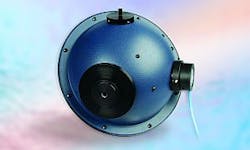Newport calibrated integrating sphere detectors operate between 400 and 1650 nm

The Model 819C and 819D calibrated integrating sphere detectors measure output light power of collimated or divergent laser beams and other light sources, respectively, delivering NIST-traceable calibration uncertainties of <3% for most measurement ranges. Silicon (Si) detector models operate from 400–1100 nm, and those with an indium gallium arsenide (InGaAs) detector operate from 800–1650 nm. Two-, 3.3-, and 5.3-in. diameter sizes accommodate various power range requirements, all of which include an SMA fiber-optic connector to allow for some light pickoff for wavelength measurement or any further analysis.
Newport (MKS Instruments)
Irvine, CA
www.newport.com/sphere
-----
PRESS RELEASE
Newport’s Improved Calibrated Integrating Sphere Detectors
• New sphere models provide excellent NIST traceable calibration uncertainties of less than 3 percent for most specified measurement ranges.
Irvine, CA – April 26, 2011 – Newport Corporation, a worldwide leader in laser and photonic
solutions that Make, Manage and Measure Light®, announces the newly enhanced calibrated Integrating Sphere Detectors. Ideal for measurement of output light power of high-power light sources, the spheres optimize the measurement geometry for laser beams and other light sources, whether collimated or divergent. The new series includes Model 819C (collimated) and Model 819D (divergent); both deliver excellent NIST traceable calibration uncertainties of less than 3 percent for most measurement ranges specified.
The calibrated integrating sphere models with a silicon (Si) detector operate from 400-1100 nm, and the ones with indium gallium arsenide (InGaAs) detector cover the spectral range from approximately 800-1650 nm. To accommodate various power range requirements, the calibrated integrating spheres are available in 2-inch, 3.3-inch, and 5.3-inch diameters.
The new design includes a robust port frame plus a variety of attachments and accessories to provide greater configuration flexibility. All sizes of the spheres include an SMA fiber optic connector on the north pole as a standard feature, allowing a small amount of light pickoff for wavelength measurement or any further analysis, without affecting the overall system calibration.
For more information about Newport’s Calibrated Integrating Sphere Detectors and related components/accessories, please visit: www.newport.com/sphere.
About Newport Corporation
Newport Corporation is a leading global supplier of advanced-technology products and systems to customers in the scientific research, microelectronics manufacturing, aerospace and defense/security, life and health sciences and precision industrial manufacturing markets. Newport’s innovative solutions leverage its expertise in high-power semiconductor, solid-state and ultrafast lasers, photonics instrumentation, sub-micron positioning systems, vibration isolation, optical subsystems and precision automation to enhance the capabilities and productivity of its customers’ manufacturing, engineering and research applications. Newport is part of the Standard & Poor’s SmallCap 600 Index and the Russell 2000 Index.
-----
Follow us on Twitter
Subscribe now to Laser Focus World magazine; it's free!